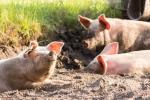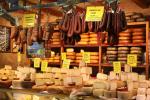H2020 NANOREMOVAS Project: Advanced multifunctional nanostructured materials applied to remove arsenic from Argentine groundwater
- Type Project
- Status Filled
- Execution 2015 -2018
- Assigned Budget 688.500,00 €
- Scope Europeo
- Main source of financing Horizon 2020
- Project website NANOREMOVAS
WP1 Successful mineralogical and geochemical characterization of the target area, complemented by groundwater characterization and monitoring. Information available in D1.1 and D1.2.
WP2 2 different adsorption materials: design, preparation, characterization, and testing of the homogeneous distribution of SPION particles impregnated on the surface of forage sponges, PAN-CNT/TiO₂-NH₂ nanofiber composites and mesoporous silica nanoparticles/polyacrylonitrile nanofiber composites (PAN nanofibers/MSiO₂ NPs). These materials are being evaluated to optimize the stability, aging, and selectivity of the adsorbent materials for arsenic removal under the demonstrator operating conditions. Further information is available in D2.1-D2.2.
WP3: Two pilot plants, one in Spain and one in Argentina, are available as demonstrators for implementing the developed materials. The monitoring test confirms the feasibility and viability of the project concept. Demonstration for interested parties has begun. More information is available in D3.1-D3.3.
WP4: Corresponding training was developed for individuals from different institutions in innovation management skills, technical assistance, and proper management of intellectual property rights to ensure knowledge and technology transfer. More information is available in D4.1.
WP5: A dissemination and communication strategy was developed and implemented to achieve the greatest possible impact, specifically to leverage the potential for long-term cooperation among the partners involved, as well as to create new networks that consolidate and expand existing ones between the academic and industrial communities. The strategy includes a promotional kit developed by the partners. More information is available in D5.1 and D5.2.
WP6: A management framework has been implemented to ensure the achievement of project objectives within the established timeframe and budget, and to ensure communication and coordination among partners and with the REA, including the use of a quality control procedure to verify project performance, impact, risks, and visibility. Further information is available in D6.1.
PROBLEM:
The presence of arsenic in surface and groundwater is well known in several key geographic areas around the world. This represents a harmful situation not only for direct human intake but also through the food chain, for example, for livestock destined for human consumption. For example, the daily ingestion of arsenic-contaminated water by livestock in Argentina is increasingly worrying, especially given the important livestock export market, where Europe is one of the main customers.
Low levels of arsenic are observed in natural forages or alfalfa grown without irrigation and used for livestock feed. Therefore, drinking water is considered the main source of arsenic for livestock (several studies reveal arsenic concentrations in groundwater samples above 0.15 mg/L, a level suggested to cause chronic poisoning in livestock). Therefore, there is a risk of exposure to human health due to the introduction of arsenic into the food chain through milk or meat, in addition to water. Daily water consumption per cow is estimated to be around 70 L/day.
Considering typical estimates on small, remote farms of 10 to 20 cows, and on medium-sized farms of around 100 to 120, this reveals the need for on-site water treatment systems capable of treating at least 700–1500 L/day and 7000–8400 L/day, providing an effluent with an arsenic content below 10 µg/L. Given the toxicity of arsenic and the large number of people exposed to its effects worldwide, there is a clear need to implement affordable and sustainable treatment methodologies on remote farms to provide safe drinking water for humans and livestock.
GOALS
To address this problem, NANOREMOVAS seeks to develop and implement a pilot plant for the remote treatment of arsenic-contaminated water, based on the application of state-of-the-art, laboratory-tested, multifunctional nanostructured materials. These materials overcome the limitations of some existing commercial products, offering improved adsorption capacity, reagent-free regeneration, high throughput, and much lower costs.
Furthermore, the implementation of this technology is carried out through cooperation between industry and academia in the water treatment sector, through a series of research and professional development training activities, along with knowledge exchange. NANOREMOVAS is establishing a lasting international partnership for knowledge transfer in the research topics involved, as a result of identified industrial needs, particularly regarding arsenic-contaminated groundwater in Argentina, providing appropriate knowledge transfer and an increase in qualified human resources.
In addition to research and innovation to demonstrate the technical and economic viability of the developed water recycling technique, seconded researchers carry out various tasks and outreach activities, promoting entrepreneurship and supporting young innovative companies in establishing technological partnerships in the water sector. Furthermore, NANOREMOVAS represents a significant contribution to the transfer of knowledge and technology from academia to industry, through prestigious partners serving as transfer centers. NANOREMOVAS will enable the rapid development of designs and equipment, processes, and industrial models for economic use based on the latest scientific results.
The daily ingestion of arsenic-contaminated water by livestock in Argentina is becoming increasingly worrying, especially given the significant size of the livestock export market, where the EU is a major customer. Because livestock feed is fed with natural forage or alfalfa grown without irrigation, drinking water is considered the main source of arsenic for livestock (several studies reveal arsenic concentrations in groundwater samples above 0.15 mg/L, a level suggested to cause chronic poisoning in livestock).
Therefore, as has been demonstrated, there is a risk of exposure to human health due to its introduction into the food chain through milk or meat. Given the toxicity of arsenic and the large number of people exposed to its effects worldwide, there is a clear need to implement affordable and sustainable treatment methods on remote farms to provide drinking water for livestock.
To address this problem and provide a solution, NANOREMOVAS aims to develop and implement a pilot plant for the remote treatment of arsenic-contaminated water based on the application of advanced, multifunctional, state-of-the-art nanostructured materials, already tested in the laboratory.
In this regard, NANOREMOVAS includes collaboration between industry and academia with partners from Europe and Argentina. In addition to the research and innovation necessary to demonstrate the technical and economic viability of the developed water recycling technique, the leading researchers will carry out a series of outreach tasks and activities, promoting entrepreneurial culture and supporting innovative young companies to establish technological partnerships within the water and livestock sectors.
Furthermore, NANOREMOVAS represents a significant contribution to the transfer of knowledge and technology from academia to industry, through the partners' well-established reputation as transfer centers, which will lead to the rapid development of industrial designs and equipment/processes/models.
IMPACT
Enhancing human resources, skills and working conditions related to research and innovation to develop people's potential and provide new career prospects through secondments (e.g. grant writing skills for SME secondees, entrepreneurial culture, knowledge transfer through planned outreach activities to train and demonstrate secondees' ability to communicate and disseminate their research, and finally, a strategic platform to prepare for future participation in different calls).
Establishing new and lasting research collaborations as a result of cross-sector or international secondments and networking activities.
Access to major infrastructure, e.g., the UAB ALBA CELLS synchrotron (i.e., study of thermodynamics and selectivity), which is helping to develop new nanomaterials to treat contaminated effluents by understanding the mechanisms of interaction between the adsorbent and the contaminant.
Participation of a sufficient critical mass to create new synergies and initiate the efficient recruitment and training of necessary talent at EU level, stimulating new collaborations for future research and innovation.
- UNIVERSITAT AUTONOMA DE BARCELONA (UAB)







